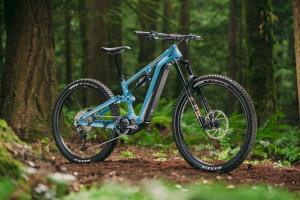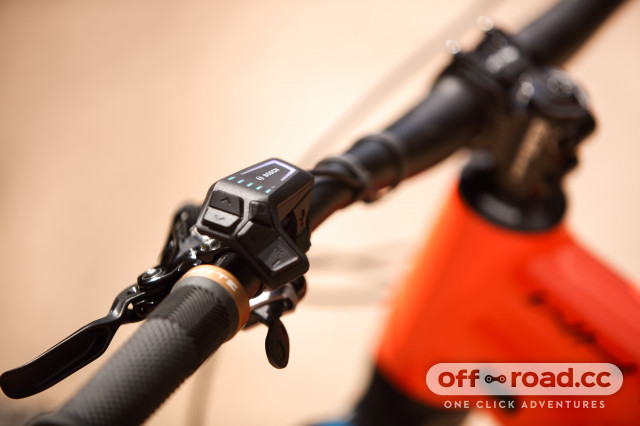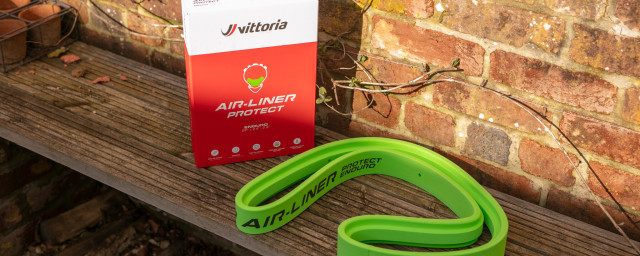First Ride: Whyte E-160 RSX 29

[Action photography by Scot Easter]
The E-160 RSX is Whyte’s freshest e-bike kitted with Bosch’s new motor, unique battery integration and a pretty blingy build. We were invited to the Forest of Dean to get a sample of how the new bike rides.
- Big Read: Racing e-bikes at the EX Enduro; how much difference does a motor make
- off-road Opinion - E-bikes aren't a menace, it's all about trail etiquette
- First Ride: Yeti 160E T-Series T1 - Yeti's first e-mtb
Whyte’s big focus with the new E-160 RSX is mass distribution with the aim of lowering the e-bike's overall centre of gravity. This has been done with a new motor and battery arrangement.
Similar to what we’ve seen on bikes like Canyon’s recent Spectral:ON, the E-160 RSX uses a transverse motor mounting design which helps lower the bike’s centre of gravity by tilting the motor upwards, making room underneath to mount the battery lower in the downtube. This is all to create a bike that’s planted, as expected of an e-mountain bike but with the cornering characteristics often found on acoustic bikes, we're told.
In conjunction with Whyte, Bosch has developed a tool-free axial slide-in Power-Tube battery design, which has allowed the frame hydroformed, 6061 alloy frame to remain stiff and strong while lowering the centre of gravity. Making the new system even cooler is that riders can choose from the 750Wh specced on the bike, and smaller 626Wh or 500Wh batteries, helping owners shed weight when a massive range isn’t necessary.
Other new features found on the E-160 RSX are the brand spanking (as in released earlier today) Bosch CX Smart System motor. With this, Bosch has brought a range of updates including an all-new remote and the display can be swapped over to suit your needs, though this bike goes without one.
The motor offers four modes, Eco, Tour Plus, eMTB and of course, turbo, or boost. The middle two act similarly to Shimano’s Trail mode, adapting to the rider’s power output, however, eMTB is a stronger power delivery, while Tour Plus sits more towards the Eco end of the spectrum. The power unit can then be connected to Bosche’s ‘Flow’ app where riders can tune the power outputs.
Whyte invited me to the Forest of Dean, one of my favourite riding spots, to swing a leg over the new E-160 RSX to get an early taster ahead of release.
Priced at £8,000, its oversized headtube is home to a Fox 38 Performance Elite fork with 160mm of travel and a GRIP2 damper. Then, the rear 160mm of squish is damped by a Fox Float X Performance that's received a custom tune, picked by Whyte's own enduro racer and bike engineer Sam Shucksmith, who tested several shock tunes just down the way from where I rode the bike, as it happens.
Fancy wireless shifting coms from a SRAM GX Eagle AXS drivetrain which is paired with SRAM's Code RSC brakes.
This bike's wheels are supplied by DT Swiss but I'm told that UK spec bikes will come rolling on Hope Fortus 30 hoops, laced to Hope Pro 4 hubs. They're then wrapped with what's becoming a classic enduro combo of the 2.5" Maxxis Assegai at the front paired with a 2.4" Maxxis DHR II at the rear. Finally, a rather nice Crankbrothers Highline 3 dropper with 150mm of drop on this large frame.
While riding, the new motor layout's lower centre of gravity was very clear. When navigating tight consecutive corners the bike was much happier to lean from one angle to the other than other e-bikes I've ridden. So much so, that it did actually feel akin to an analogue bike.
This effect in cornering means that the bike straddles the line between the zippier handling of a normal bike and the chunk-taming capability of an e-bike. While its weight is very well hidden when pushing it through turns, it’s still a hefty machine, which makes the suspension work harder and arguably better over lumpy stuff, as we all know.
The brand says that the linkage hasn’t seen much of a change from previous designs, rather the engineers have taken an ‘if it ain’t broke, don’t fix it’ approach but there has been a lot of attention paid to the bike’s shock tune, as I mentioned before and first impressions of the suspension platform are good. It’s got that hallmark sensitivity that you’ll usually find of a weighty e-bike but as it reaches its midstroke, the rear end offers a good and useful amount of feedback. Granted my time on the bike was limited, but through mid-corner compressions and short technical sections, the rear end felt poised and lively but never felt vague.
Whyte admitted that the E-160’s 75.3° seat tube angle is a bit more relaxed compared to a lot of enduro-spec bikes but it places the rider in that ‘just right’ position. While it can make the cockpit feel a little stretched on steeper sections of uphill, it makes the rear wheel very easy to weight, boosting grip when it’s needed the most which is incredibly helpful considering the extra power output by the motor.
While it aids the bike’s sorted cornering, the 340mm bottom bracket is very low. Even when specced with mega short 165mm cranks, I managed to strike a pedal a number of times. This happened when climbing too which I found a bit of a shock, but it’s nothing a short adjustment period won’t fix.
Elsewhere, the E-160 RSX’s geometry is pretty progressive. This large frame rocks a 1269.2mm wheelbase with a 64.5° head tube angle. These numbers rustle up a tonne of confidence when descending, making it a bike that's more than capable when the trail gets questionable, especially with the plush but supportive suspension.
The bike’s combination of a progressive shape, low-slung centre of gravity and weight makes it an uncompromising bike that becomes easy to ride surprisingly quickly. It’s encouraging but forgiving too; I’ve rolled into sections with perhaps more speed than I’m used to and while it got the heart rate going a little, the Whyte seemed to take it all in Its stride with full composure.
As I only had a couple of hours with the bike, I can’t comment too much on the new Bosche motor but during that time, I kept it mostly in the eMTB mode. While maybe a little noisy, power delivery felt natural both when cranking uphill, and when putting in the odd pedal stroke when descending. The bar-mounted controller is littered with buttons, however, which took some time to work out.
It’s looking like Whyte has created an e-bike that successfully blends handling characteristics of both analogue and e-bikes. It corners unlike any e-bike I've ridden before and handles chunks with an impressive level of confidence. Generally, it’s an easy and comfortable bike to ride at speed. Hopefully, we’ll soon have one in for a proper test so we can properly put the bike through its paces.




















